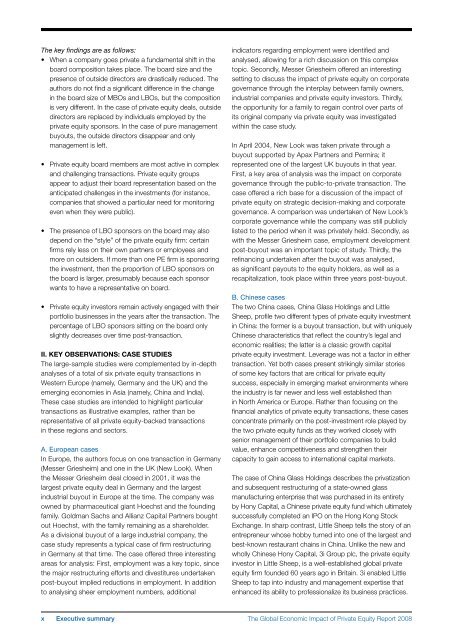The Global Economic Impact of Private Equity Report 2008 - World ...
The Global Economic Impact of Private Equity Report 2008 - World ...
The Global Economic Impact of Private Equity Report 2008 - World ...
- No tags were found...
Create successful ePaper yourself
Turn your PDF publications into a flip-book with our unique Google optimized e-Paper software.
<strong>The</strong> key findings are as follows:• When a company goes private a fundamental shift in theboard composition takes place. <strong>The</strong> board size and thepresence <strong>of</strong> outside directors are drastically reduced. <strong>The</strong>authors do not find a significant difference in the changein the board size <strong>of</strong> MBOs and LBOs, but the compositionis very different. In the case <strong>of</strong> private equity deals, outsidedirectors are replaced by individuals employed by theprivate equity sponsors. In the case <strong>of</strong> pure managementbuyouts, the outside directors disappear and onlymanagement is left.• <strong>Private</strong> equity board members are most active in complexand challenging transactions. <strong>Private</strong> equity groupsappear to adjust their board representation based on theanticipated challenges in the investments (for instance,companies that showed a particular need for monitoringeven when they were public).• <strong>The</strong> presence <strong>of</strong> LBO sponsors on the board may alsodepend on the “style” <strong>of</strong> the private equity firm: certainfirms rely less on their own partners or employees andmore on outsiders. If more than one PE firm is sponsoringthe investment, then the proportion <strong>of</strong> LBO sponsors onthe board is larger, presumably because each sponsorwants to have a representative on board.• <strong>Private</strong> equity investors remain actively engaged with theirportfolio businesses in the years after the transaction. <strong>The</strong>percentage <strong>of</strong> LBO sponsors sitting on the board onlyslightly decreases over time post-transaction.II. Key observations: Case studies<strong>The</strong> large-sample studies were complemented by in-depthanalyses <strong>of</strong> a total <strong>of</strong> six private equity transactions inWestern Europe (namely, Germany and the UK) and theemerging economies in Asia (namely, China and India).<strong>The</strong>se case studies are intended to highlight particulartransactions as illustrative examples, rather than berepresentative <strong>of</strong> all private equity-backed transactionsin these regions and sectors.A. European casesIn Europe, the authors focus on one transaction in Germany(Messer Griesheim) and one in the UK (New Look). Whenthe Messer Griesheim deal closed in 2001, it was thelargest private equity deal in Germany and the largestindustrial buyout in Europe at the time. <strong>The</strong> company wasowned by pharmaceutical giant Hoechst and the foundingfamily. Goldman Sachs and Allianz Capital Partners boughtout Hoechst, with the family remaining as a shareholder.As a divisional buyout <strong>of</strong> a large industrial company, thecase study represents a typical case <strong>of</strong> firm restructuringin Germany at that time. <strong>The</strong> case <strong>of</strong>fered three interestingareas for analysis: First, employment was a key topic, sincethe major restructuring efforts and divestitures undertakenpost-buyout implied reductions in employment. In additionto analysing sheer employment numbers, additionalindicators regarding employment were identified andanalysed, allowing for a rich discussion on this complextopic. Secondly, Messer Griesheim <strong>of</strong>fered an interestingsetting to discuss the impact <strong>of</strong> private equity on corporategovernance through the interplay between family owners,industrial companies and private equity investors. Thirdly,the opportunity for a family to regain control over parts <strong>of</strong>its original company via private equity was investigatedwithin the case study.In April 2004, New Look was taken private through abuyout supported by Apax Partners and Permira; itrepresented one <strong>of</strong> the largest UK buyouts in that year.First, a key area <strong>of</strong> analysis was the impact on corporategovernance through the public‐to‐private transaction. <strong>The</strong>case <strong>of</strong>fered a rich base for a discussion <strong>of</strong> the impact <strong>of</strong>private equity on strategic decision-making and corporategovernance. A comparison was undertaken <strong>of</strong> New Look’scorporate governance while the company was still publiclylisted to the period when it was privately held. Secondly, aswith the Messer Griesheim case, employment developmentpost-buyout was an important topic <strong>of</strong> study. Thirdly, therefinancing undertaken after the buyout was analysed,as significant payouts to the equity holders, as well as arecapitalization, took place within three years post‐buyout.B. Chinese cases<strong>The</strong> two China cases, China Glass Holdings and LittleSheep, pr<strong>of</strong>ile two different types <strong>of</strong> private equity investmentin China: the former is a buyout transaction, but with uniquelyChinese characteristics that reflect the country’s legal andeconomic realities; the latter is a classic growth capitalprivate equity investment. Leverage was not a factor in eithertransaction. Yet both cases present strikingly similar stories<strong>of</strong> some key factors that are critical for private equitysuccess, especially in emerging market environments wherethe industry is far newer and less well established thanin North America or Europe. Rather than focusing on thefinancial analytics <strong>of</strong> private equity transactions, these casesconcentrate primarily on the post-investment role played bythe two private equity funds as they worked closely withsenior management <strong>of</strong> their portfolio companies to buildvalue, enhance competitiveness and strengthen theircapacity to gain access to international capital markets.<strong>The</strong> case <strong>of</strong> China Glass Holdings describes the privatizationand subsequent restructuring <strong>of</strong> a state‐owned glassmanufacturing enterprise that was purchased in its entiretyby Hony Capital, a Chinese private equity fund which ultimatelysuccessfully completed an IPO on the Hong Kong StockExchange. In sharp contrast, Little Sheep tells the story <strong>of</strong> anentrepreneur whose hobby turned into one <strong>of</strong> the largest andbest-known restaurant chains in China. Unlike the new andwholly Chinese Hony Capital, 3i Group plc, the private equityinvestor in Little Sheep, is a well-established global privateequity firm founded 60 years ago in Britain. 3i enabled LittleSheep to tap into industry and management expertise thatenhanced its ability to pr<strong>of</strong>essionalize its business practices.Executive summary<strong>The</strong> <strong>Global</strong> <strong>Economic</strong> <strong>Impact</strong> <strong>of</strong> <strong>Private</strong> <strong>Equity</strong> <strong>Report</strong> <strong>2008</strong>















